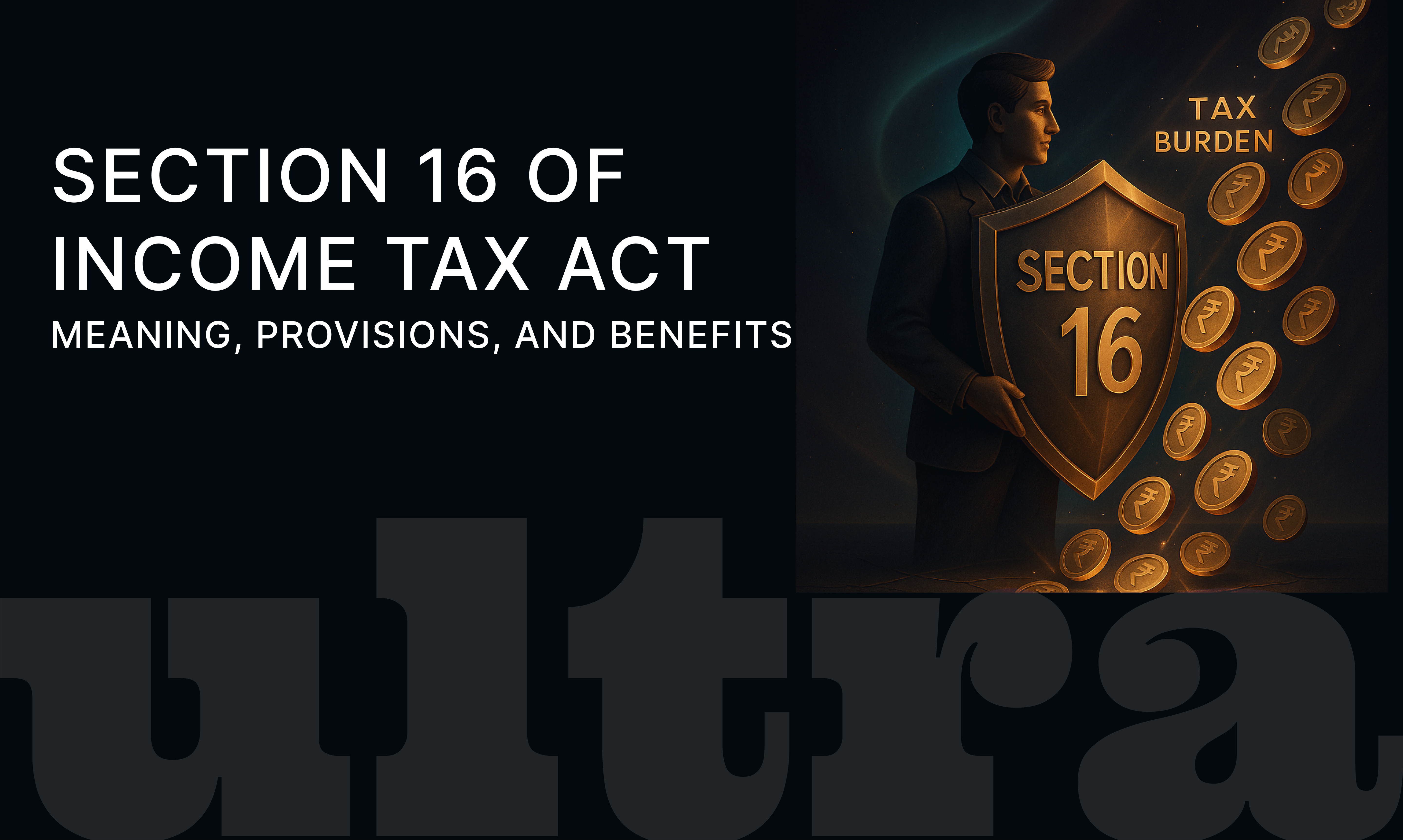Section 16 of Income Tax Act: Meaning, Provisions, and Benefits
17 July 2025 · Sachin Gadekar
A Complete Guide to Section 16, Standard Deduction, and Tax Relief for Salaried Individuals

What is Section 16 of Income Tax Act?
At Ultra, our mission is to help you understand personal finance better. Whether you are a salaried professional or self-employed, knowing how Section 16 of Income Tax Act works can help you save taxes lawfully.
In this article, we explain Section 16 of Income Tax Act, its sub-sections Section 16(ia) and Section 16(iii), and how salaried employees can claim standard deduction under this provision.
Section 16 of Income Tax Act, 1961 provides salaried individuals with specific deductions from their salary income. It was introduced to offer relief to employees by reducing their taxable salary.
Key takeaway: Section 16 mainly deals with standard deduction and other allowances for salaried employees.
Breakdown of Section 16
Section 16 has three sub-sections:
Section 16(i): Entertainment Allowance
Section 16(ia): Standard Deduction
Section 16(iii): Tax on Employment
Let’s understand each of them.
1. Section 16(i): Entertainment Allowance
This applies mainly to government employees. Under this clause, government employees can claim a deduction for the entertainment allowance received.
Maximum Deduction Allowed:
20% of basic salary, or
₹5,000, or
Actual entertainment allowance received
whichever is least.
Private sector employees are not eligible for this deduction.
2. Section 16(ia) of Income Tax Act: Standard Deduction
The Section 16(ia) standard deduction was reintroduced in Budget 2018 to simplify tax benefits for salaried employees.
As per FY 2024-25, every salaried person and pensioner can claim a flat standard deduction of ₹50,000 from their gross salary income.
You don’t need to submit any bills or proof to claim this standard deduction.
Example of Standard Deduction
Suppose your gross salary is ₹6,00,000 per year.
Under Section 16(ia):
Standard Deduction = ₹50,000
Taxable Salary = ₹5,50,000
This deduction directly lowers your taxable income and therefore your tax liability.
3. Section 16(iii) of Income Tax Act: Tax on Employment
This clause allows a deduction for any tax paid on employment (also known as professional tax) by the employee. The amount paid is fully deductible from your gross salary.
How Section 16 Helps Salaried Employees
Reduces taxable salary.
No documentation hassle for standard deduction.
Professional tax and entertainment allowance also get deducted under this section.
Makes salary tax calculations simpler.
How to Claim Deductions under Section 16
You don’t have to file separate paperwork for claiming standard deduction. It is auto-calculated by your employer while computing TDS.
When you file your ITR, ensure that your Form 16 reflects this deduction under the “Deductions under Section 16” head.
Section 16 vs Section 80C
Many confuse Section 16 with Section 80C. Both provide deductions but they are different.
Section 16: Directly reduces your taxable salary income.
Section 80C: Allows deduction for specific investments like PPF, ELSS, Life Insurance Premium, etc.
So you can claim both to reduce your tax outgo smartly.
Who Can Claim Section 16 Deduction?
Salaried employees (including pensioners for standard deduction)
Government employees (for entertainment allowance)
Employees paying professional tax
Documents Required
No special documents are needed for standard deduction. Just ensure your employer deducts professional tax if applicable and includes the figures in your Form 16.
Latest Updates on Section 16
The standard deduction amount under Section 16(ia) has been revised a few times. Earlier it was ₹40,000 and now stands at ₹50,000.
Budget changes may revise this limit in the future, so always check the latest Income Tax rules.
Important Points to Remember
Standard deduction is available even if you switch jobs mid-year.
Pensioners can claim the deduction under “salary income” since pension is taxable as salary.
There is no standard deduction for self-employed or business professionals under Section 16.
FAQs about Section 16 of Income Tax Act
Q1. What is Section 16 of Income Tax Act?
Section 16 provides standard deduction, entertainment allowance, and professional tax deduction from salary income.
Q2. How much is the standard deduction under Section 16(ia)?
The standard deduction is ₹50,000 per year for FY 2024-25.
Q3. Can pensioners claim standard deduction under Section 16?
Yes, pensioners are eligible for standard deduction under Section 16(ia).
Q4. What is Section 16(iii) of Income Tax Act?
It allows deduction for professional tax paid by the employee.
Q5. Do I need to submit proof to claim standard deduction?
No. It is automatically applied by your employer while computing your salary.
Final Thoughts
Section 16 of Income Tax Act is one of the simplest yet most useful sections for salaried people to reduce taxable income. Make sure your employer accounts for this deduction while calculating TDS and keep your Form 16 handy for your ITR filing.
At Ultra, we help you understand tax and investing topics in clear, simple language. Stay connected for more tax guides, investment tips, and smarter money moves.